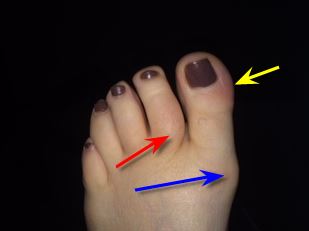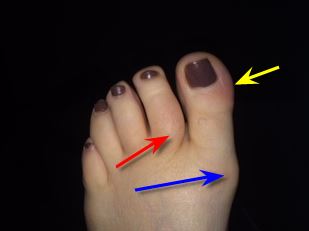Not what you're looking for? CLICK HERE INSTEAD
The response to the question below was authored by Marc Mitnick DPM
ankle and left toe pain/redness
by Nancy
(Monument, CO USA)

ingrown nail or gout?
Hi. I had blood work done to rule out gout (uric acid came back a 5.6 MG/DL) because my symptoms look just like it. Uric acid claims to be in the "normal" zone. The redness and pain are on my left toe. I initially thought I might have had an ingrown toenail even though the redness wasn't butted up against my toe bed. It's located more on the outside of my toe near the joint. The pain is on the side of the toe and wraps around to the bottom, over the joint (not the base). The pain happens when walking and pressing on it. Otherwise, I don't feel it.
About a year ago, I was being treated for a tendon in my left knee…because of this, I walked funny and caused issues with my ankle. The ankle is almost better (other than it feeling tight when I first walk with pain that I imagine an elderly person has from arthritis). I also developed an undiagnosed neroma on the bottom of my foot (the pad by the base of my toes) but have successfully found relief from that having PT (while my knee and ankle were being worked on).
Also, I have slight swelling at the base of the toe NEXT to my big toe…no reason what soever and only mildly painful when someone squeezes it.
This BIG toe thing, looks like it could be an infection, but I haven't a cut, a poke….how could an infection come without a reason? Anyway, back to gout. Is it possible that I have gout? I am female (higher risk in males) and the number of my uric acid is normal.
Hoping you can help…last question: Is a podiatrist the best way to go or orthopedic surgeon who specializes in ankle and foot problems? Thanks so much!
RESPONSE
Hi Nancy,
As I usually start my replies to questions is the fact that since I cannot actually examine you, I am essentially guessing as to what is going on here but based on your narrative and picture I think I can give you some insight as to what it "probably" is.
Lets talk about gout first. Gout is an inflammation of a joint secondary to the deposit of uric acid crystals in the joint fluid which cause inflammation. It would be equivalent to adding sand to the oil compartment in your car.
If you look
Additionally, gout is usually only seen in post menopausal women and I am assuming you are not there yet. The other problem is that uric acids in many instances are normal during a gout attack and only begin to rise again, days after the attack, so your blood work is worthless.
Furthermore, gout will hurt all the time regardless of whether you are walking on the foot or pressing on the toe. In a classic gout attack, the pain will usually start early in the morning, before you even get out of bed; there is no previous history of trauma and for no accountable reason usually the big toe joint (blue arrow) is the joint most affected, but keep in mind it can occur in any joint in the foot as well as the hand.
So, from where I am sitting this does not seem like gout to me. On the other hand it does sound more like an ingrown nail.
An ingrown nail will usually only hurt when walking and will certainly hurt if you press your finger against the side of the toe. Keep in mind, there are two types of painful ingrown nails; an infected ingrown nail and a non-infected ingrown nail. Both will appear red. In most cases, but not always, there will be some sort of drainage coming out of the toe if it infected, but keep in mind just because there is no visible pus does not mean it is not infected.
This problem needs to be address by a local doctor in your area. Undoubtedly, this would be best treated by a podiatrist because in the event it is determined to be an ingrown nail, some treatment will be required and a podiatrist is the one to do it.
As far as the swelling in the second toe, (red arrow) my first thought would be an arthritic flare up or perhaps a capsulitis. In both conditions, the joint becomes inflamed and swells and yes pressure against the swelling will cause pain. The smart money would be to point this out to the doctor as well.
Marc Mitnick DPM
DISCLAIMER
ADDITIONAL REFERENCES
University of Rochester Medical Center
American Academy of Pediatrics
Columbia University Department of Rehabilitation



Recent Articles
-
Vitamin D impact on health
Feb 06, 23 07:17 PM
Researchers are suggesting that the effectiveness of Vitamin D in fighting and preventing disease is predicated on a persons body mass index (BMI). The thinner the person the greater the positive impa… -
Foods to speed up healing
Feb 01, 23 02:41 PM
One of the best ways to help yourself heal faster after surgery is to eat well. Getting the proper nutrition will provide your body with the essentials it needs to promote healing. Here is a suggestio… -
Cancer and Type 2 Diabetes
Jan 25, 23 04:52 PM
An article revealing that older type 2 diabetics have a higher incidence of cancer then non-diabetics. It is suggested that cancer may surpass CVD as the number one cause of death in older diabetics. -
Does glucosamine or MSM reduce arthritis pain?
Jan 22, 23 01:41 PM
A good review of the possible benefits to taking glucosamine, chondroitin or MSM for arthritis. Always beware of the possible side effects of over the counter supplements. -
shin splints
Jan 18, 23 05:12 PM
A great review on the various causes of shin splints, along with treatment options. -
Whats new in skin cancer?
Jan 15, 23 08:32 PM
A presentation of newer skin protection combinations in an effort to better protect the skin from the hazards of sun exposure. -
Causes and risk factors of warts
Jan 14, 23 05:02 PM
A good review of the causes of warts and protective measures you can take to prevent developing them. -
Do chronic wounds need to be dressed daily?
Jan 11, 23 02:18 PM
Because of supply chain shortages as well as staffing shortages particularly during the pandemic, many institutions extended the time between dressing changes for chronic wounds. Is this really the be… -
Food choices that raise your risk of type 2 diabetes
Jan 08, 23 10:07 AM
A good review of how blood sugars can become elevated and the harm that can do. Certain food groups have a tendency to raise your blood sugars and should be avoided. -
Outcome stats from Scarf bunionectomy
Jan 03, 23 03:04 PM
The Journal of Foot and Ankle Surgery recently reported a meta analysis of outcomes in 1583 Scarf bunionectomies that met their inclusion criteria. Adverse events did not seem to be any better or wors…



